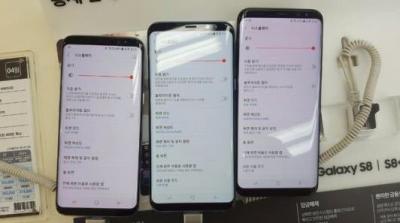Samsung started shipping its Galaxy S8 and Galaxy S8+ phones in Korea, and some of the first customers are complaining that the display have a reddish tint - which did not go away even after correcting the color display settings. This issues was quickly labeled as "Red Gate"... will Samsung face a new crisis?

Samsung itself says that there are no quality issues - and that the problem can be adjusted. Customers are welcome to replace their device, though, at service centers in Korea.
Reporters from Korea speculate that the cause of this problem may be the new deep-red emitter adopted by Samsung in its latest AMOLEDs, or perhaps the Diamond Pixel pentile matrix.
It's obviously very hard to know what is going on - and this is pure speculation at this stage. I discussed this with Raymond Soneira from DisplayMate and he clarifies that his own two Galaxy S8 units are accurately calibrated and don't show any red tinting when everything is set to the Factory Defaults.
In the Galaxy S8 users can shift the white point to make the display more reddish or more bluish with the user color balance controls that are available under display settings. Raymond told OLED-info that he can reproduce the published photo that way.
Raymond says that Samsung indeed moved to a new deep-red emitter (which enabled them to increase the color Gamut) - but that deeper red does not change the white point. The pentil matrix is certainly not to blame, either. Raymond says that this problem could be caused by defective OLED panels, misadjusted displays - or software bugs. Or perhaps some setting is causing this (for example the night shift blue light filter is adjustable on the S8 which could be changed so the display has a reddish tint) which the consumers are not aware of.
The most likely issue, according to Raymond is the Color Balance controls. We'll wait to hear more news from Korea. One thing is clear, Samsung does not need another faulty flagship phone launch...
Comments
A few things. Initially when I heard about the color balance feature- I though it was a neat way to adjust for screen warmth- not a necessity to compensate for variability in the manufacturing process. And if I knew the latter, I wouldn't have bought the phone. Second, the color balance feature only works in adaptive display mode. And third, it doesn't address lack of uniformity- for example splattering of pinks or blues on the screen edges or worse. Again, if I had known these quirks were inherent in Samsung's amoled technology- I wouldn't have bought the phone. Finally if is inherent in their technology- it doesn't explain the 60% of phones that have no issue.
Finally, there are characteristics of Amoled screens that are acceptable and represent a trade off. For example, tinting does change based on viewing angle- on the other hand, there are deeper blacks and more robust colors and contrast. This kind of trade-off is acceptable. Red, blue or purple splattering is, at least for me, not.


Recently when I was passing some time at London Heathrow airport in an electronics store, I noticed Samsung phones and tablets with OLED displays had very noticeable screen burn-in which showed up as reddish areas when viewing a clear white background say in the Chrome browser. On my return back to US, I visited a BestBuy store and again I noticed the same issue with Samsung OLED devices. I am not an expert but I wonder if the blue OLED pixels which have shorter life start fading after a while and make those areas appear reddish.